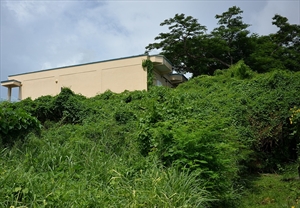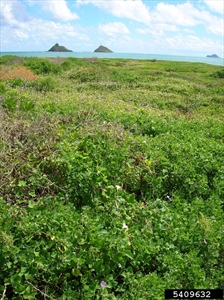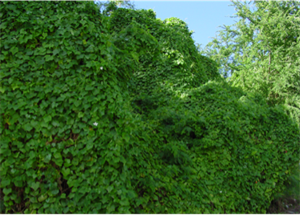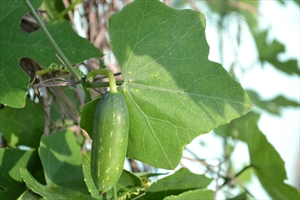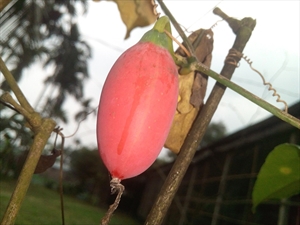Ivy gourd. It is also known as the scarlet-fruited gourd, little gourd, scarlet gourd.
Pacific Pests, Pathogens and Weeds - Online edition
Pacific Pests, Pathogens & Weeds
Ivy gourd (495)
Coccinia grandis; previously, it was known as Bryonia grandis, Coccinia cordifolia. It is a member of the Cucurbitaceae.
Africa, Asia, North America, the Caribbean, Oceania. It is recorded from Australia, Federated States of Micronesia, Fiji, Guam, Marshall Islands, Northern Mariana Islands, Papua New Guinea, Samoa, Solomon Islands, Tonga, and Vanuatu. It is a native of East Africa.
An aggressive, fast-growing perennial vine smothering crops and natural vegetation, including shrubs and small trees (Photos 1&2). Common in abandoned gardens, wastelands, disturbed areas, including roadsides. Global distribution suggests it favours seasonally dry tropics. It occurs up to 1100 masl. Note, even in places where it does not set seed (e.g., Guam), it is still an aggressive weed.
Stems of several metres long, free of hairs, growing from tuberous side roots serving as storage organs. Leaves alternate along the stems, heart-shaped to 5-lobed, up to 10 cm long and wide, hairy below (Photo 3). Tendrils from leaf axils assist climbing (Photo 6). Male and female flowers on separate plants, on 1-5 cm stalks from leaf axils, single, white, trumpet-shaped, 3-5 cm long, with five oval lobes, and five leaf-like structures (bracts) below (Photo 4). Fruits, smooth, green at first, then bright red, 2.5-6 cm, with light brown seeds (Photos 5-7).
Spread over short distances by its tuberous roots, and further afield by seeds carried by birds, rodents and possibly pigs. Stem pieces regrow when in contact with soil. Spread internationally associated with its introduction for medicinal use and as a food.
Environmental impact results from smothering natural vegetation preventing the regeneration of native plants and reducing diversity; economic impacts in urban areas from ivy gourd being a weed of wastelands, covering fences, power poles, and other structures, and as a weed smothering agriculture crops, e.g., sugarcane in Fiji. Apart from these direct effects, it is host of many pests in the Cucurbitaceae family. CABI lists the following: cucumber moth (Diaphania indica) (see Fact Sheet no. 33); pumpkin beetle (Aulacophora species (see Fact Sheet no. 40); melon fly (Bactrocera cucurbitae) (see Fact Sheets nos. 21, 169, 170); melon aphid (see Fact Sheet no. 38); leafminers (Liriomyza species) (see Fact Sheet no. 110); squash leaf-footed bug (Leptoglossus species) (see Fact Sheet no. 165); and Bemisia species (see Fact Sheet no. 284).
Used widely in traditional medicines for many ailments, e.g., juice from roots and leaves used to treat diabetes. The shoot tips are used in Asian cooking, and leaves and green fruits in salads.
BIOSECURITY
The chances of introduction of ivy gourd is high in sub-tropical, and tropical regions. Countries not yet infested should consider all likely pathways for entry, and apply quarantine measures accordingly. Particular attention should be given to its popularity in folk medicines and as a food.
Coccinia grandis is on the Global Invasive Species Database (2021) of information on alien and invasive species that negatively impact biodiversity, managed by the Invasive Species Specialist Group of the IUCN Species Survival Commission: (http://www.iucngisd.org/gisd/speciesname/Coccinia+grandis).
BIOLOGICAL CONTROL
A stem-boring moth (Melittia oedipus) and leaf-mining beetle (Acythopeus cocciniae) released in Hawaii with beneficial effect; however, similar benefits were not obtained in Guam or in the Northern Mariana Islands.
CULTURAL CONTROL
- Physical & Mechanical:
- Hand-pulling and removing underground storage roots is effective for small plantings. Collect all root and stem pieces and burn them, otherwise they may resprout if left on or in the soil.
- Slashing (and any kind of mechanical cultivation) is less effective unless root and stem pieces are collected.
Foliar sprays of triclopyr, glyphosate (against young plants), and basal bark applications of 2,4-D have been recommended. However, finding basal stems within dense stands of the vine is difficult. In Australia, a minor use permit allows several herbicides against vines until June 2023, including: 2,4-D; 2,4-D + picloram; dicamba; MCPA; triclorpyr; triclorpyr + picloram; triclorpyr + picloram + aminopyralid.
--------------------
Note, EU approval to use glyphosate ends in December 2022; its use after that date is under discussion.
____________________
When using a pesticide, always wear protective clothing and follow the instructions on the product label, such as dosage, timing of application, and pre-harvest interval. Recommendations will vary with the crop and system of cultivation. Expert advice on the most appropriate herbicides to use should always be sought from local agricultural authorities.
AUTHOR Grahame Jackson
Information from CABI (2019) Coccinia grandis (scarlet-fruited ivy gourd). Invasive Species Compendium. (https://www.cabi.org/isc/datasheet/14659); and Coccinia grandis (2013) Pacific Island Ecosystems at Risk (PIER). (http://www.hear.org/pier/species/coccinia_grandis.htm); and from Ivy Gourd (Coccinia grandis) (2011) Invasive Species Fact Sheet 05. Pacific Islands Area. USDA NRCS. (https://www.nrcs.usda.gov/Internet/FSE_DOCUMENTS/nrcs142p2_037095.pdf). Photo 1 Mingus 19. (https://commons.wikimedia.org/wiki/File:Invasive_Ivy_Gourd.jpg). Photos 2&5 Forrest & Kim Starr Starr Environmental, Bugwood.org. Photo 4 Jaiprakashsing. Young fruit of Coccinia grandis. (https://commons.wikimedia.org/wiki/File:Young_Coccinia_grandis.jpg). Photo 6 Abdullah AL Shohag. (https://www.flickr.com/photos/189060791@N03/50318670331/in/dateposted/). Photos 3&7) Konrad Englburger, Pohnpei, Federated states of Micronesia.
Produced with support from the Australian Centre for International Agricultural Research under project HORT/2016/185: Responding to emerging pest and disease threats to horticulture in the Pacific islands, implemented by the University of Queensland and the Secretariat of the Pacific Community.
